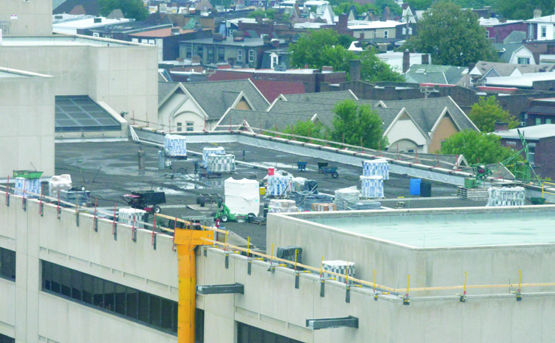Welcome Back: Posvar’s new roof to reduce Pitt’s pollution

August 19, 2014
Pitt’s Posvar Hall, an office and lecture space for the University, will help students breathe easier this fall with a new roof that cleans up air pollution.
Pitt spokesman John Fedele said Pitt purchased roof materials from Siplast, an advanced roofing and waterproofing company based in Dallas, Texas.
The roof will remove the pollution created “…by more than 50 [cars] per 20,000 square feet of roofing” each year, Fedele said. He said the hypothesis is “based on studies using estimated conditions (sunlight, humidity, and NOx [nitrous oxide gases]) for Los Angeles and mileage of the average U.S. household vehicle (11,300 miles).”
Kirk Goodrum, Siplast’s director of research and development, said the roof will transform the airborne pollutant nitrogen dioxide (NO2) by giving it a third oxygen molecule when “activated by ultraviolet light” from the sun. The roof changes the chemical structure of the NO2, creating NO3, a nitrogen-based salt that will sit on top of the roof. Goodrum said the same technology is used on skyscrapers with self-cleaning windows and on self-cleaning concrete.
Emily Elliott, an assistant professor in Pitt’s department of geology and planetary sciences, said “NOx pollution comes from power plants [and] vehicle tailpipes, [but also] naturally from lightning [and] soil microbes.”
According to Professor Elliott, the nitrogen-based salt could potentially wreak havoc in the Monongahela River when it gets washed away in roof stormwater because the nitrogen is then transferred from the air to the water. Professor Elliott also said that “it is important to reduce air pollution.”
Taking into consideration Posvar’s roof size and the estimate that the roof will dissolve pollution created by about 50 cars per 20,000 square feet of roofing, Fedele said this reduction would equate to 217 cars per year. But the polluted air must be near the roof — for example, the roof can’t reach NOx near the Petersen Events Center.
Dan Marcinko, the assistant vice chancellor of administration and University sustainability coordinator for facilities management, said the new roof system will cost roughly $1.2 million and will last “at least as long as a normal roof.”
According to Fedele, the roof has “a 20-year warranty.” Fedele and Marcinko agreed that the roof should last longer than that.
According to Claire Matway, a junior majoring in urban studies and co-president of a student organization called Free the Planet, this project is a step that increases Pitt’s sustainability.
“I think it’s great that this technology exists — that we can repair buildings using materials that will help eliminate nitrous oxides from the air — and that Pitt is utilizing it,” Matway said in an email. “This proves Pitt’s interest in taking steps to reduce its environmental impact.”







